API Lifecycle
BLOG
12 min read
What Is the API Lifecycle? Key Stages and Best Practices for Success
Application Programming Interfaces have become indispensable for tying software together. They power everything from social media linkages to cloud services and financial processing, enabling many systems to function together. Digital transformation relies heavily on APIs, but how well they're managed over their whole lifecycle will determine how successful they are.
The phases of planning, developing, deploying, and eventually retiring an API are all included in the API lifetime. Proper management of this process guarantees that APIs are secure, dependable, and adaptable to changing business requirements. In this blog, we'll examine the critical phases of API development and offer advice on how to make the most of them. Understanding the API lifecycle is important whether you work as a developer, product manager, or business owner.
What Is the API Lifecycle?
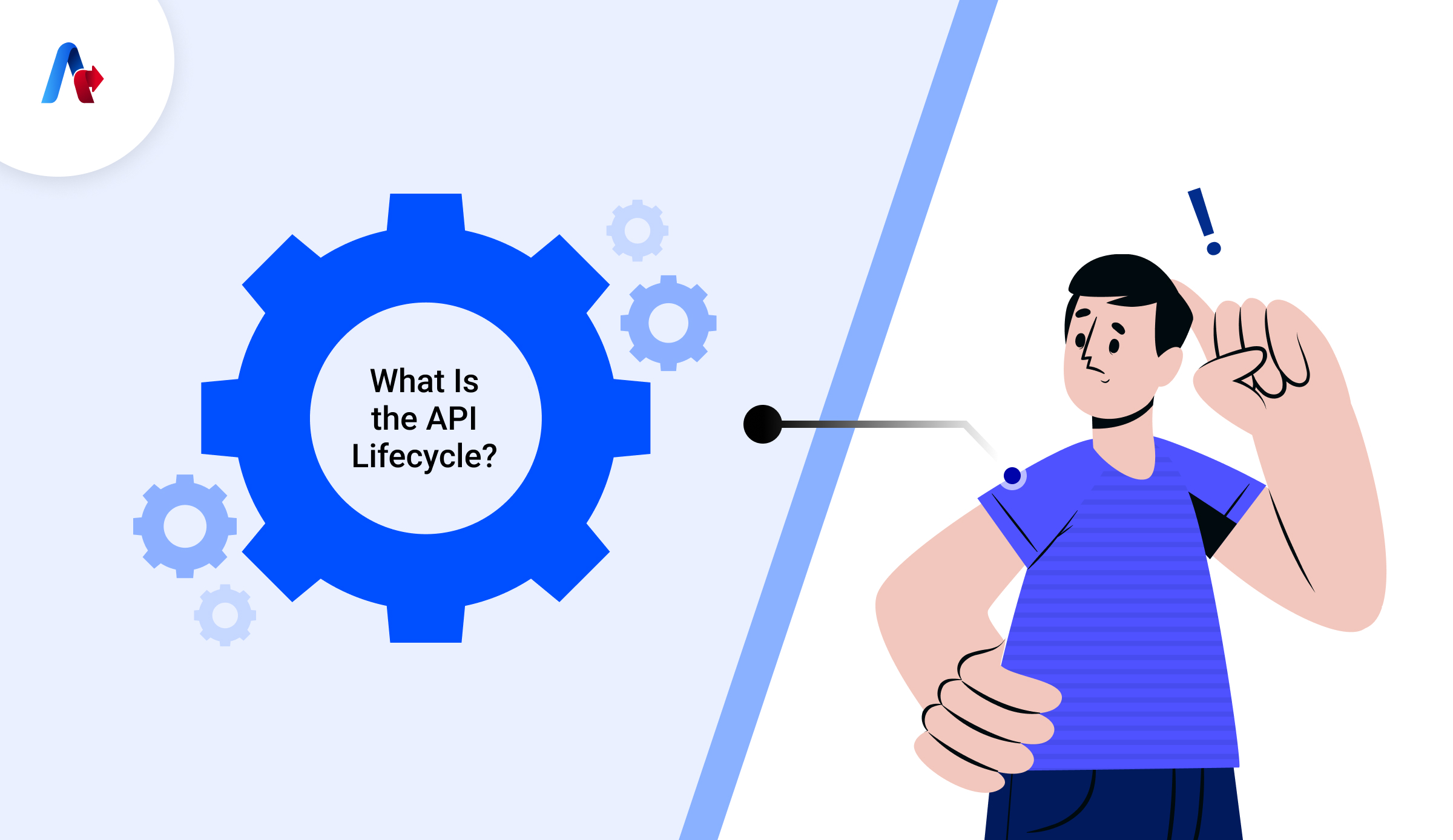
The process of overseeing an API from its inception to its decommissioning is known as the API lifespan. It covers every step of developing an API, making sure that everything goes as planned from design and testing to deployment and monitoring. In order to ensure that APIs consistently give value, an efficient API lifecycle helps maintain a balance between functionality, security, and performance. A well-managed API lifetime encourages creativity and agility while making it easy for companies to adjust to shifting consumer needs.
How the API Lifecycle Works?
The creation, development, and administration of APIs over time are governed by the API lifecycle, which is an ongoing process. Every phase of this lifecycle builds on the one before it, guaranteeing that the API satisfies the needs of the consumers who depend on it as well as the developers who design it. In contrast to conventional software products, APIs must be continuously updated, adapted, and monitored to be useful in rapidly changing technological contexts.
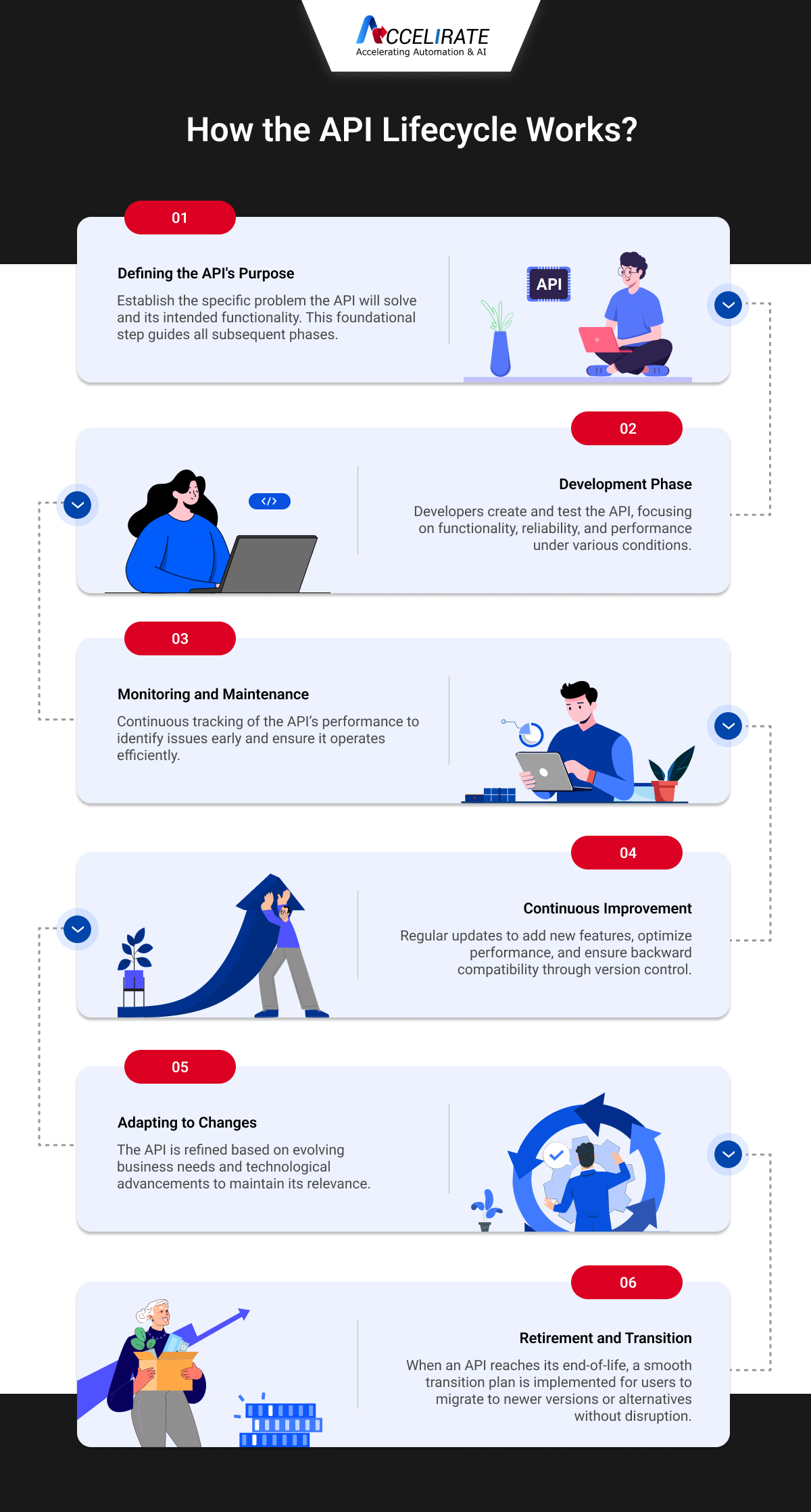
At its core, API lifecycle management involves balancing performance, security, and usability while considering future needs and iterations. This lifecycle begins with defining the API's purpose and scope, ensuring that it solves a specific problem or delivers a valuable function. Following this, the development phase brings the API to life, allowing developers to build and test its functionalities. Once in operation, APIs require constant monitoring to ensure they function as intended under varying loads and conditions.
Another key aspect of the lifecycle is continuous improvement. APIs often need versioning as new features are added or performance optimizations are made. Version control allows developers to introduce updates while maintaining compatibility with existing integrations. This constant cycle of development, deployment, monitoring, and improvement defines how an API's lifecycle operates.
Efficiently overseeing the API development life cycle necessitates meticulous preparation, implementation, and refinement at every phase. It guarantees that the API will hold value over time, that it will support corporate objectives, and that it will adjust to changes in user needs or technical improvements. As APIs age and must eventually be retired, this cycle also involves getting ready to make sure users may easily switch to newer versions or alternatives.
Need help optimizing your API lifecycle?
Connect with experts todayBreaking Down the 8 Stages of the API Lifecycle
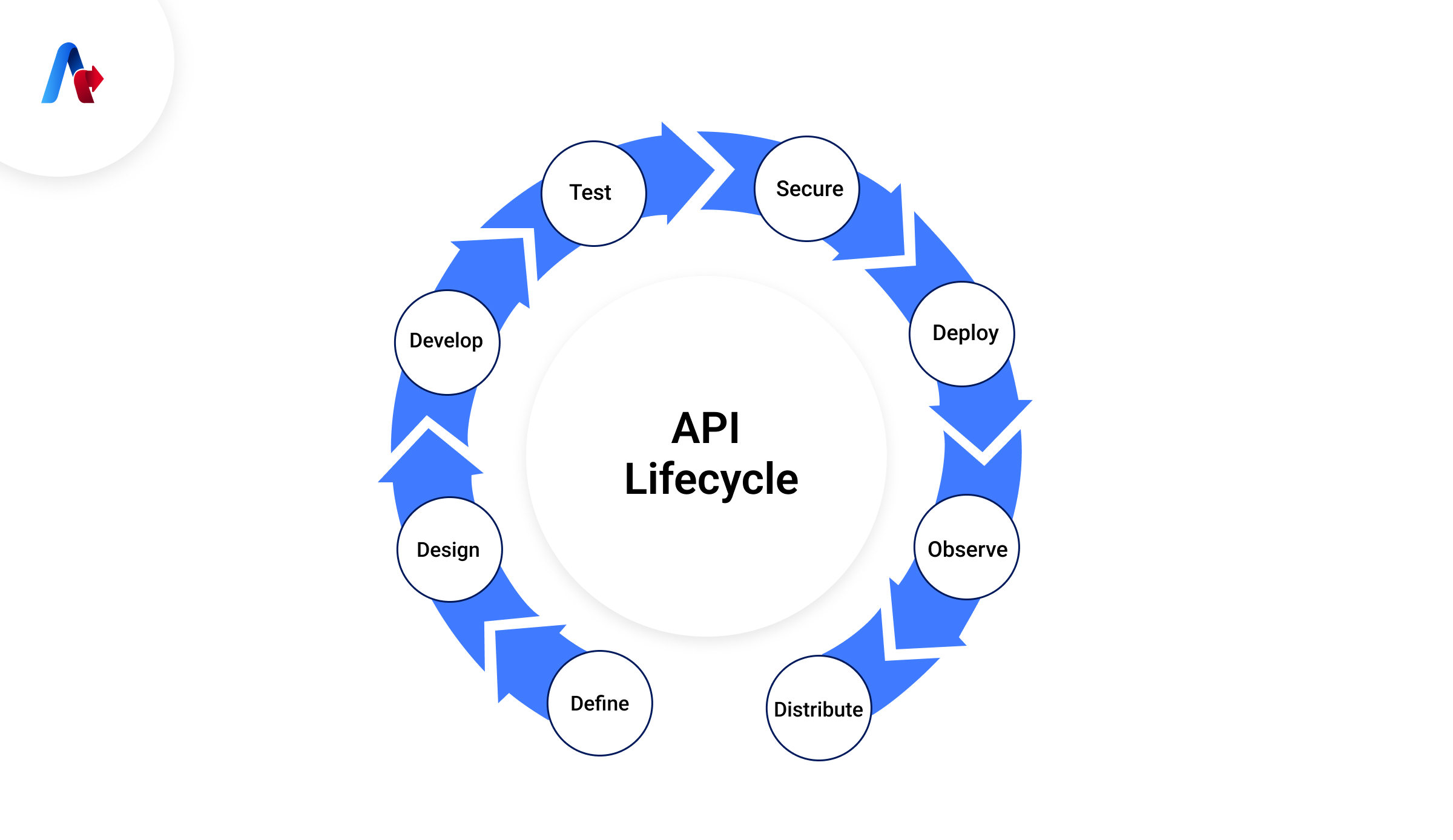
1. Planning & Design
The first stage of the API lifecycle involves conceptualizing the API's purpose and defining its key functionality. During this phase, developers and stakeholders identify the use cases, establish the requirements, and decide on the technologies and protocols the API will use. A detailed design is created, outlining the API’s architecture, endpoints, methods, and data models. Planning and design are critical, as they form the foundation for the entire API development life cycle.
2. Development
Once the design is complete, developers begin building the API. During the development phase, coding takes place, and the API is configured to handle different requests and responses. This stage also involves integration with backend systems, databases, and third-party services. It's essential that developers follow best practices to ensure the API is secure, scalable, and optimized for performance.
3. Testing
Thorough testing is crucial to ensure that the API performs as expected. In this stage, various testing methodologies like functional testing, performance testing, and security testing are employed to identify and fix any bugs or vulnerabilities. Automated testing tools can be used to simulate different scenarios, ensuring that the API is robust and capable of handling real-world conditions.
4. Documentation
A well-documented API is easier for developers to understand and integrate. In this stage, comprehensive documentation is created, explaining how the API works, detailing its endpoints, and providing code samples. Good documentation ensures that the API is user-friendly and can be easily adopted by third-party developers, making it more likely to gain traction in the market.
5. Deployment
After passing testing, the API is ready for deployment. The API is pushed to production, where it becomes available for use. At this stage, developers need to ensure that the API is correctly configured, with security protocols in place to protect against unauthorized access and attacks. Deployment also involves setting up monitoring systems to track the API's performance and usage.
6. Versioning & Scaling
Over time, APIs evolve. Versioning allows developers to introduce new features or improvements without disrupting existing users. By maintaining backward compatibility, developers ensure that users can continue to interact with older versions of the API while adopting newer functionality. Version control is essential for long-term API lifecycle management, allowing the API to grow and adapt to changing requirements.
7. Monitoring & Analytics
Once the API is live, ongoing monitoring is required to track its performance, security, and usage. API lifecycle management tools can help gather real-time analytics, offering insights into API latency, error rates, and user activity. Continuous monitoring helps identify bottlenecks and potential areas for improvement, ensuring the API remains efficient and responsive over time.
8. Decommissioning
The final stage of the API lifecycle is decommissioning, where an API is retired because it is no longer relevant or has been replaced by a newer version. In this phase, developers notify users of the API's end of life, providing a timeline for discontinuation and offering migration paths if necessary. Proper decommissioning ensures a smooth transition for users and prevents disruptions to the services relying on the API.
What Are the Benefits of API Lifecycle Management?
API lifecycle management offers numerous benefits that contribute to the success and sustainability of APIs throughout their journey, from conception to decommissioning. Managing the lifecycle effectively ensures that APIs remain scalable, secure, and adaptive to both business and technological changes. Here are some key benefits of proper API lifecycle management.
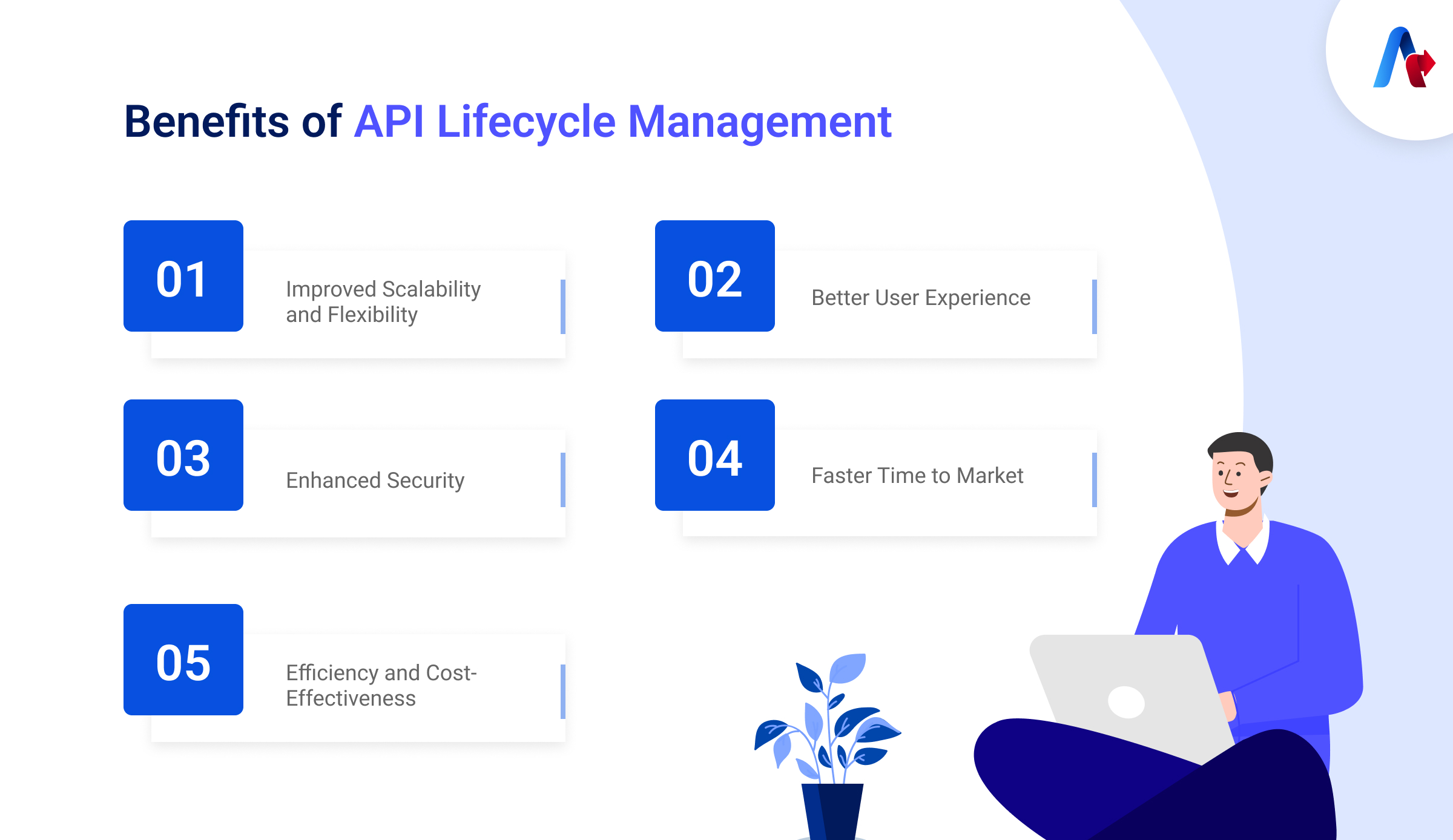
1. Improved Scalability and Flexibility
By managing each stage of the API lifecycle, developers can ensure that APIs are flexible and scalable. As an organization grows, its APIs must handle increased traffic and user requests. With the right API lifecycle management tools, APIs can be easily scaled to meet these demands without compromising performance.
2. Enhanced Security
APIs are often the target of security breaches, making it essential to address vulnerabilities at every stage of the API development life cycle. Proper management includes setting security protocols like encryption, authentication, and monitoring for suspicious activity. Continuous security testing and updates help protect APIs from potential threats.
3. Efficiency and Cost-Effectiveness
Effective API lifecycle management optimizes resource allocation by streamlining development and reducing redundancy. Automated testing, monitoring, and analytics help developers detect and resolve issues early, reducing costly downtime. This leads to greater efficiency in API deployment and maintenance, ultimately saving both time and money.
4. Better User Experience
Well-managed APIs deliver consistent performance, reducing the likelihood of failures or slow response times. By monitoring usage patterns and implementing API lifecycle management best practices, developers can ensure that the API is intuitive, reliable, and easy to integrate, improving the overall user experience.
5. Faster Time to Market
A structured approach to managing the API lifecycle stages helps shorten development cycles. With defined processes and API lifecycle management tools, businesses can quickly design, test, and deploy APIs, allowing them to launch new services or products faster and remain competitive.
What Are the Challenges of API Lifecycle Management?
Although API lifecycle management has several advantages, developers and organizations must overcome a unique set of obstacles to enable seamless functioning. Organizations can take proactive measures to mitigate these issues during the API development life cycle by being aware of them.
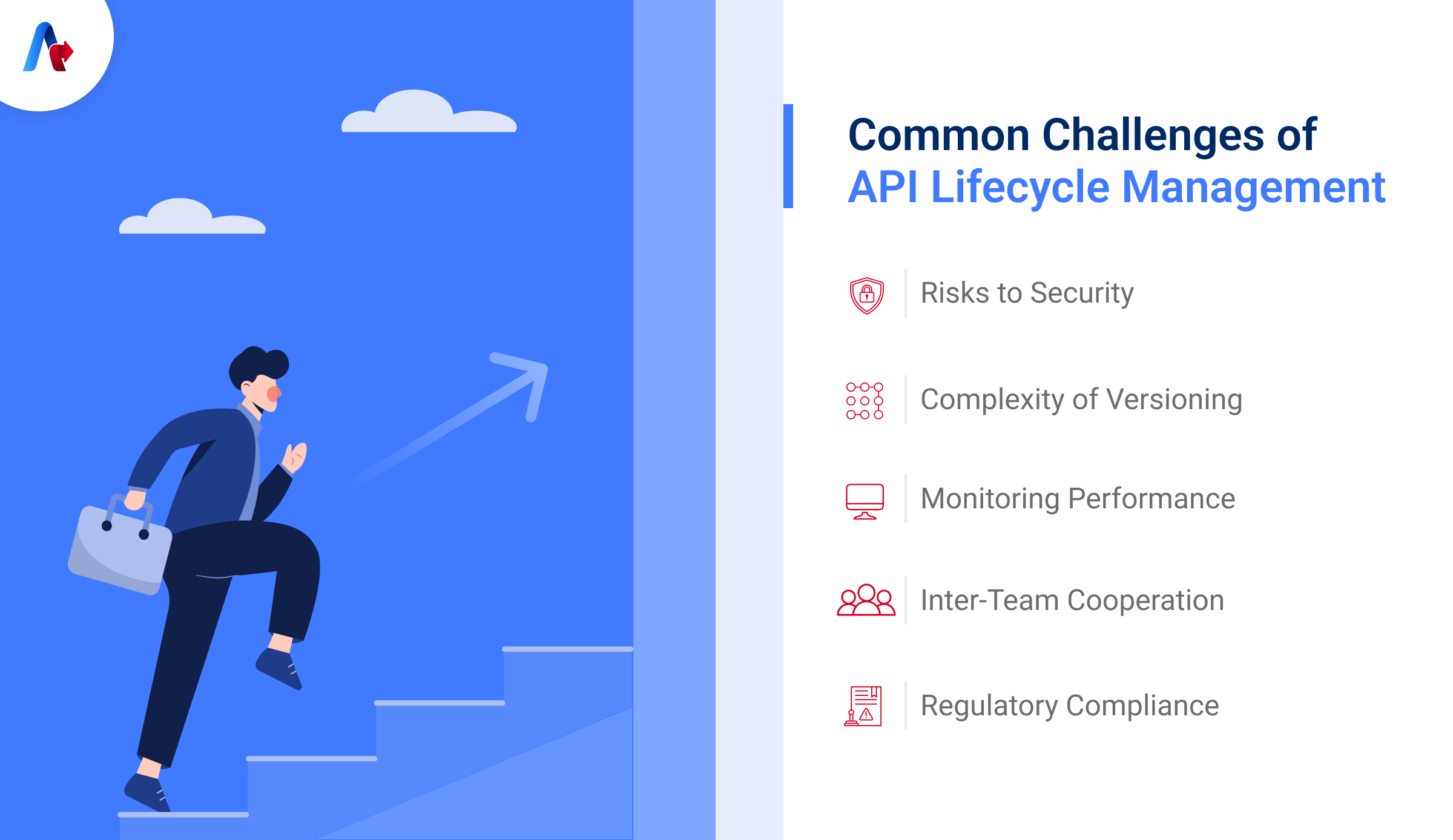
1. Risks to Security
At every point of the API lifecycle, security is still a major concern because APIs expose sensitive data. The API and its users may be compromised by cyberattacks, data breaches, and illegal access. Strong security measures, such as authentication and encryption, must be implemented; yet, maintaining them across API versions and contexts can be difficult.
2. Complexity of Versioning
Versioning is frequently necessary as APIs develop in order to add new functionality or enhancements. It can be difficult and complicated to maintain backward compatibility across several API versions. In order to prevent upgrades from interfering with already-existing integrations, developers must carefully plan and carry out API lifecycle management.
3. Monitoring Performance
Performance metrics including response times, latency, and error rates must be tracked continuously after an API is implemented. It can be challenging to locate bottlenecks and maintain peak performance over time, particularly as traffic increases. To overcome this obstacle, real-time monitoring and analytics require the use of specialist API lifecycle management solutions.
4. Inter-Team Cooperation
Developers, testers, security specialists, and business stakeholders are among the teams involved in the many stages of the API lifecycle. It can be challenging to ensure seamless collaboration between various teams, particularly when working with different technologies or in separate time zones.
5. Regulatory Compliance
APIs frequently have to abide by industry standards and data protection requirements. Another level of complexity to API lifecycle management is making sure that APIs adhere to laws like GDPR or HIPAA at every stage of their existence. Non-compliance can result in legal issues or fines, making this a critical but challenging aspect to manage.
Best Practices in API Lifecycle Management
In order to maintain consistency, security, and scalability throughout the API development life cycle, it is necessary to adhere to a set of best practices for API lifecycle management. Organizations can avoid common errors and build high-quality APIs that provide value over time by following these suggestions.
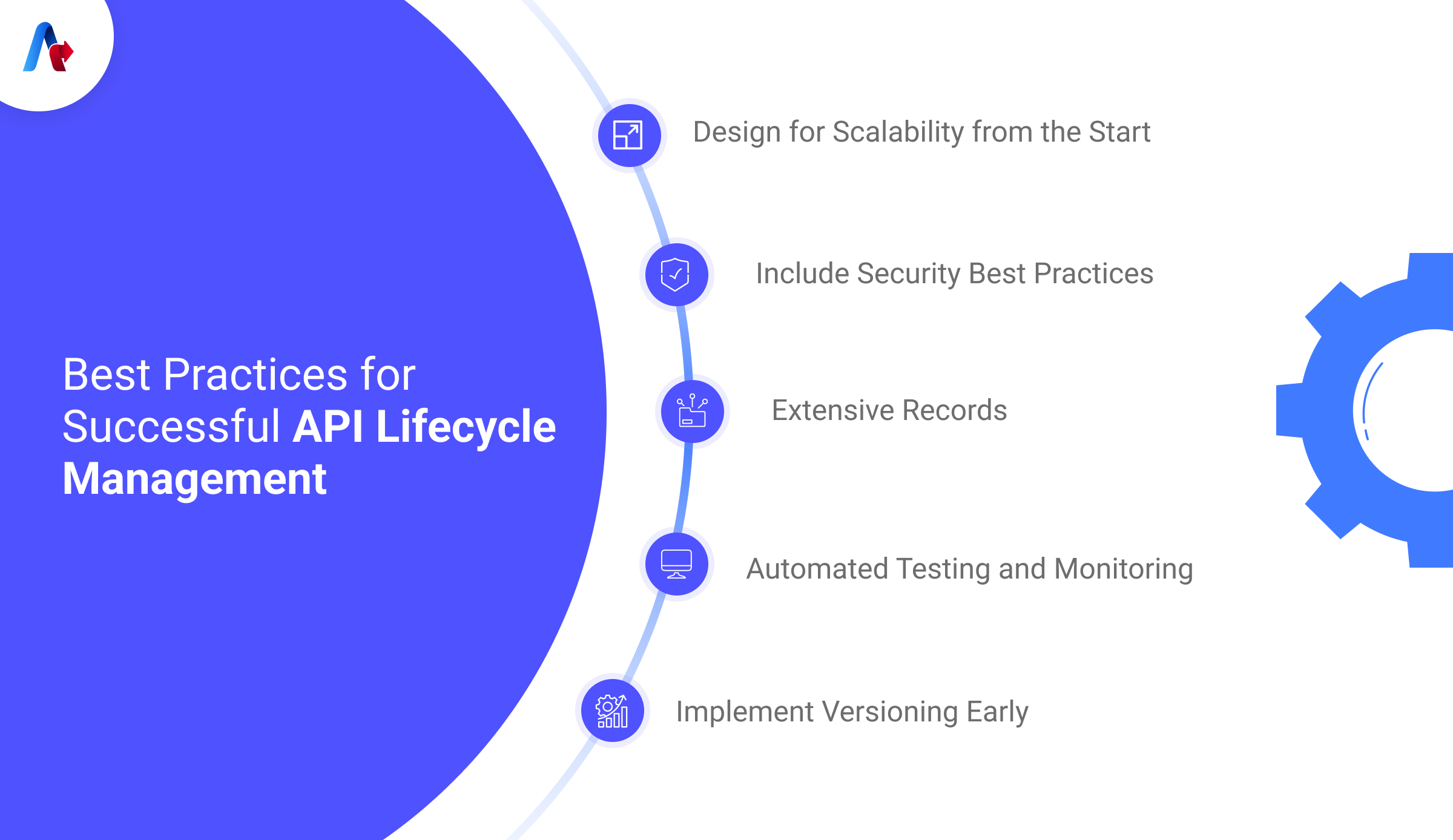
1. Design for Scalability from the Start
When planning and designing an API, it's essential to consider future scalability. As demand grows, your API should be able to handle more traffic and additional features. By designing APIs with scalability in mind, developers can avoid costly reworks and ensure smooth growth over time. Using API lifecycle management tools to simulate traffic and load during testing can help.
2. Include Security Best Practices
Every phase of the API lifecycle, from design to retirement, should prioritize security. Token-based authentication, encryption, and routine security audits are examples of best practices. Best practices for API lifecycle management also include making sure sensitive data is never exposed and putting rate-limiting in place to thwart DDoS assaults.
3. Extensive Records
Keeping thorough, lucid documentation is one of the most important aspects of API lifecycle management. Adoption is increased by well-documented APIs because they are simpler to use and integrate. Code samples, methods, authentication protocols, and API endpoints should all be included in this description. This procedure can be automated with the use of tools like Swagger, which will make it simpler to keep documentation current.
4. Automated Testing and Monitoring
Automated testing tools are invaluable in the API development life cycle. Regular testing helps identify issues early, while automated monitoring ensures the API performs as expected once deployed. Using API lifecycle management tools for continuous monitoring can track API performance, usage, and potential security threats, ensuring your API remains stable and secure over time.
5. Implement Versioning Early
Introducing versioning from the start of the API lifecycle stages helps manage changes and ensures backward compatibility. Proper versioning allows users to migrate to newer versions of an API without disrupting their existing systems. This ensures long-term sustainability while also allowing the API to evolve with new features and improvements.
Ready to implement API best practices?
Connect with experts for consultationLeverage API Management Solutions to Scale Your Business
API lifecycle management is essential for companies designing, building, and deploying APIs. By following a structured approach and leveraging the right API management solutions, businesses can ensure security, manage versioning and retirement, and optimize API performance throughout their lifecycle. As digital platforms and cloud-native solutions continue to evolve, staying ahead of trends and adopting efficient API management strategies will be crucial for long-term scalability and success in a microservices-driven world.
FAQs
API lifecycle management is evolving fast as technology advances. With more businesses using digital platforms, API management is expected to become more automated and use AI and machine learning to improve security, monitor performance, and simplify the design and deployment of APIs. As cloud-native platforms grow, flexible API solutions that work across different cloud environments will become more common.
Managing the API lifecycle involves different roles. Developers handle the coding and testing, while product managers ensure the API meets business goals. API architects focus on long-term strategy and scalability. Larger organizations may have dedicated API teams for security, version control, and performance monitoring. IT teams also support the infrastructure.
The REST API lifecycle includes planning, development, deployment, and ongoing maintenance. First, the API’s structure is planned and designed. Then, it’s coded and tested. After deployment, it’s continuously monitored for performance and security. Versioning ensures smooth updates and retirement of old versions. Each step ensures a reliable API experience.

